SMYTH AND THE LOYALIST, A TWO-LEVEL complex that’s half tasting menu restaurant, half neighborhood hangout, will extend the hot West Loop restaurant row onto Ada street when it opens later this summer. So many forms of urban reinvention nestle together in this densely compacted neighborhood, and the opening of this pair of restaurants from two veterans of Charlie Trotter’s and Alinea will lead the transformation of yet another chunk of the city from its 20th century industrial past into a glitzy global center of culinary culture—
—At least, that’s how you might start an article about it. But it’s 90 degrees on a Saturday, and I’m zooming south on I-57 in Kankakee county, and the fancy food world is way behind me. I’m out in the wide open prairies where food actually comes from, a very different kind of culinary culture.
At Manteno, I make a perfect right angle off the highway and beeline a few miles to a numbered country road, then make another precise 90º turn, as if I’m driving my car with Etch-a-Sketch knobs. I’m looking for a point on the grid called The Farm, which seems like the beginning of a comic misadventure, since it’s nothing but farms around here. Fortunately, they make it easy to know you’re there:
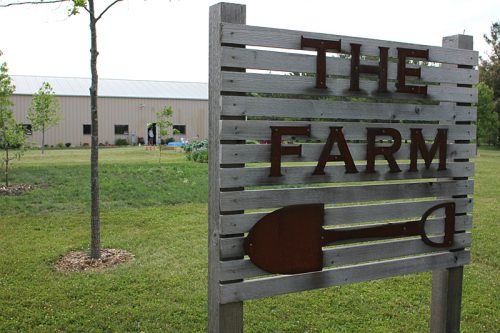
I suppose the name fits as a partner for a restaurant called Smyth. In fact The Farm looks less like a farm than most of the farms I’ve passed—none of the signs of monoculture of corn or soybeans that are typical of an Illinois farm. There’s not even an old white frame house (though I soon see the square of grass where one burned down). It turns out that this is why it’s the perfect partner for Smyth and The Loyalist, an hour behind me in Chicago. An unconventional farm joining up with a couple of innovative chefs to experiment—and see what they can produce together.
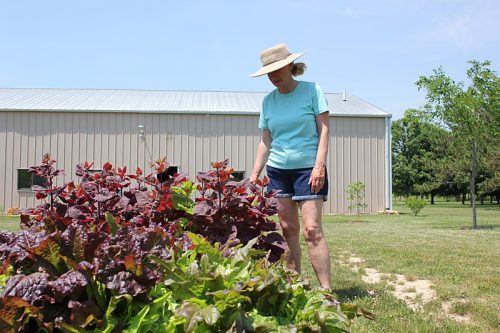
Rebecca Papineau
ALAN PAPINEAU FOUND THE FARM WHEN he went to mail a package of his wife Rebecca’s sugar cookies to a nephew, and the post office didn’t open till 8:30. So he drove around Bourbonnais to pass the time, and spotted a for sale sign. Something about this wild piece of land two miles from their home, overgrown and with the burnt patch where the house once stood, spoke to him in a way that it didn’t to its neighbors. Who mostly asked, “Why’d you buy that place?”
Alan is a retired Com Ed lineman, and he already owned a farm where he grows ornamental trees—”If you ever want a workout, come dig trees,” he says. Rebecca is a part-time nurse as well as a Master Gardener—a designation given by the state of Illinois to skilled gardeners who volunteer to educate others. She too saw a blank slate for their retirement years where they could grow what they liked and let their city grandchildren run free outdoors. (Fooditor readers have already met one side of their family—their daughter Megan and her husband Dan host this annual sausage party.)
So this is the first important point about The Farm—they weren’t really looking to make money off of it, certainly not to pave the land with the cash crops (corn, soybeans) that cover much of Illinois. Instead they got busy fixing it up to their tastes—in four years they’ve cleared the front, planted boxes and rows of fruit trees (some moved over from that tree farm), and converted the horse barn into a workshop and a small kitchen. You know, to relax.
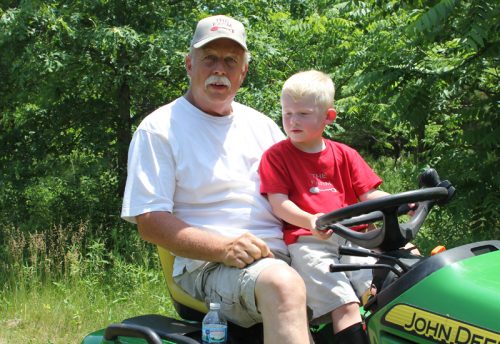
Alan Papineau and grandson Landon
Alan says, “My buddies that are still working will drive up and say, what’re you doing? What’d you retire for if you’re gonna do this?” But there’s work and there’s work. “My last 15 years, working for Com Ed, I was a first responder”—the guy who had to run out and repair something at night in the rain. “I can come in here at night, sit back, open the refrigerator, have water or a beer, go home, and the phone’s not ringing,” he says, with the gentle satisfaction of a man who has found peace at last.
As I drive up, Rebecca and their son Elliott, who works as a financial analyst in Chicago, are poking around a box of greens in the front yard. There are a lot of greens, by the standards of a home gardener, but not a lot of greens by the standards of a restaurant—a busy place could go through this on a Saturday night. That’s when I learn that the goal here isn’t really to supply a restaurant’s full needs, but to give them the ability to experiment with what grows in Illinois—a kind of lab farm for them.
Though at the moment, with lettuces growing fast and ready to bolt, Rebecca wishes a restaurant was already open to have a busy night. “I don’t know what to do with all this lettuce. I wish I had somewhere for it to go,” she muses, then points out some French breakfast radishes that are similarly straining to escape the ground.

Elliott Papineau and friend
It was Elliott, the internet foodie in the family, who first suggested the idea of finding a restaurant in Chicago for his parents to grow for. Alan says he didn’t know if he really wanted to get that involved with the restaurant world. But when John Shields put out a query on Twitter for a supplier of black walnuts, Elliott asked his dad if he had any. “I said yeah, there’s a whole walnut grove out here, how many do you want? So John and Karen came here last August to check out the place, and asked us if we would be interested in growing vegetables for them.”
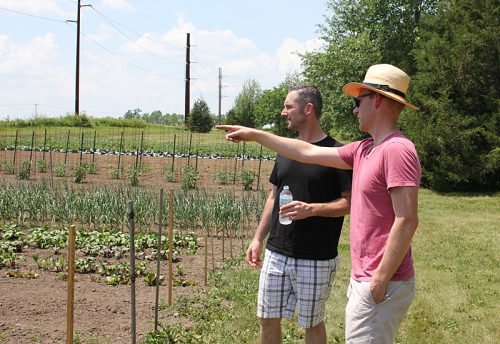
Elliott points something out to John Shields
I’M OUT GETTING PHOTOS WITH ELLIOTT of all the things growing around the different corners of the farm, from neat rows of potatoes or corn to dense thickets of wild berries, when the Shields arrive. They’re here with their daughters, Cicely and Lillie, who are 5 and 2, plus Nick Romero, who helped open Grace and will be the chef de cuisine for Smyth, the fine dining half.
John and Karen Urie Shields met while working at Charlie Trotter’s, and John helped open Alinea. But they left Chicago to make their own names—taking over and making a farm-to-table restaurant out of an existing place called Town House in Chilhowie, Smyth County, Virginia. Closer to Knoxville and Asheville than any major town in Virginia, John admits “you had to want to find Chilhowie,” but at least the food press did—John made Food and Wine’s best new chefs in 2010 and was a James Beard Awards semi-finalist.
After five years there, they had the idea of opening a restaurant in Georgetown, but looking for a space proved frustrating enough that they wound up doing pop-ups in Chilhowie to keep their hands in. It was Bill Kim who lured them back to Chicago by tipping them off to an available space in Chicago near his Urban Belly. John carries on the story as we sit around the table in the barn, the womenfolk preparing lunch in the kitchen, Elliott’s son Landon, 3, occasionally interrupting us to announce his latest urgent discoveries in earthworm science.
It’s inspirational here, walking around looking at the product. It really gets the ideas going—moreso than the farmers market.
“I got to town and, obviously, was looking to make relationships,” John says. “But I wasn’t pressing too hard, and I’d become a fan of black walnuts over the last few years, living in Virginia and just surrounded by them.” When Elliott responded to his tweet, “I got excited about the prospect of a relationship, not knowing if there was any interest at all, but just kind of threw it out there. And then we came out and met Alan and Rebecca and their family, and they’re incredible people. That’s really what it comes down to, working with people we like being around.”
“I didn’t know what to expect, some guy who thinks it’s all us hillbillies down here south of 80,” Alan laughs. “But it was cool, we just clicked. We could communicate.”
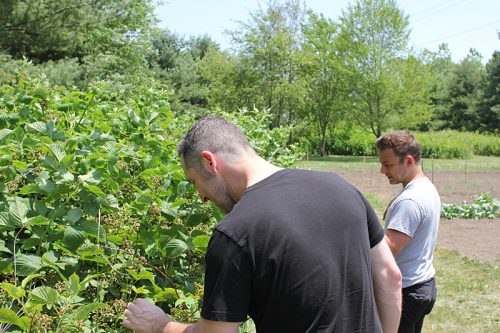
John Shields and Nicholas Romero, looking at black raspberries
I ask John how much of the total produce used in the restaurant will come from The Farm. “I don’t know,” he admits. “I think a lot of it will be used upstairs,” at the tasting menu restaurant Smyth, “and more of the farmers market stuff downstairs,” at The Loyalist. “But we’ll see. It’s smaller portions [at Smyth], so I think the farm can handle that, versus downstairs, which we hope will be a little bit busier, bigger portions.”
I ask how they picked a lot of the things they wanted to have planted. “A lot of the things that were growing were already here, except for the herbs and maybe the lettuces,” John says. “But they were already producing a number of things. Maybe they had three or four different kinds of potatoes, but we added a few more to the mix, some different kinds of beans.”
“Over the winter, John and Becky spent hours on the phone with the different seeds,” Alan says. “One was educating the other, because there was some things that we could grow here, and some things that we couldn’t. John would mention something to Becky that she’d never heard of, so he would tell her all about that. They fed off each other, to see what we could grow here.”
“You throw seeds in the ground and say, please come up, because you never know,” Alan adds. “Some of this stuff is an experiment, we’ve never grown it before.”

What’s the benefit of working directly to have your own food grown, versus just shopping, I ask? “We worked at Charlie Trotter’s and Alinea, and we always got amazing product, but the relationship stopped at the door,” John says. “As a young cook I didn’t have any connection with how it was actually grown, or who was working to produce it, and I’d take it for granted. You don’t respect the vegetables, or whatever the product might be, in that sense. You try to, but it’s not the same as when you actually meet the people that grow it. You cook it differently. You think about it differently. It’s inspirational here, walking around looking at the product. It really gets the ideas going—moreso than the market or anywhere else.”
“Coming out to see it, but also having them grow what we want, in a certain way, is nice,” Nicholas adds. “You go to the farmers market, and everyone kind of has the same stuff, at the same time of the year.”
But how much have they really thought about how they’ll use the things they’re growing here? John says, “We try to plan the menu to a certain point, but I’m pretty spontaneous when I cook, and I like to have that flexibility. So the farm allows for some of that. We might have an idea for a dish and, oh, we want to cover it with pea flowers. So we say, can we get a whole line of peas going, and then maybe for a few weeks, three weeks, we’ll have that dish, where we can literally cover it with ten or 15 flowers, as opposed to one or two as a garnish.”
He turns to the item that brought them here, black walnuts. “It gives us a little edge that we can show our guests, look what a fresh black walnut tastes like. It has that essence of black walnut, but it’s more like a cucumber in the sense of its texture, and its flavor is much more subdued, more salad-like, crunchy and delicious.”
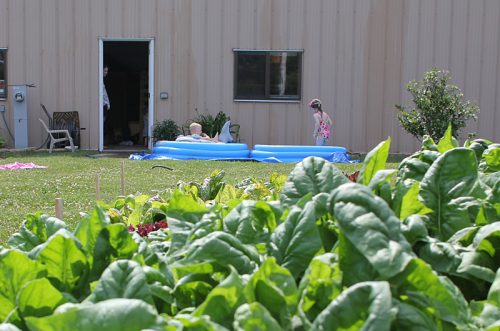
Gallery: What’s growing at The Farm
ABOUT A BEER LATER, LUNCH IS SERVED—grilled lamb and beef from a neighbor, a salad of Anson Mills farro verde with spring vegetables in it that John made, that couldn’t possibly be a better advertisement for simple cooking of things fresh from the ground. There’s also strawberry shortcake made by some combination of Rebecca, Elliott’s wife Kristen, and oh yes, Karen Shields, who might know a thing or two about dessert, having worked for Gale Gand at Tru before going to Trotter’s. She’s been wrangling the kids, especially her own 22-month-old Lillie, so I’ve barely had a chance to talk to her up to this point, but take advantage of a moment to do so after lunch.
With two small children, she’s looking for a different role from her husband’s. “I don’t want to make any promises to myself now, because you just never know,” Karen says. “This whole process [of building out the restaurant] has pulled me away from the kitchen. Sadly, but in a good way. They’re in school till 3:30, and I kind of envision dropping them off, and working all day, and then picking them up and having family meal at the restaurant. I’ll probably work a few night services, but not five nights a week.”
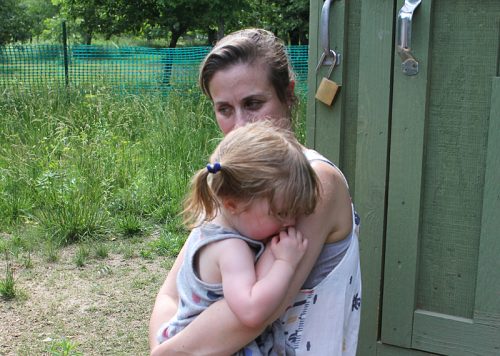
Karen and Lillie Shields
“But we work all day long,” she says. “Creative things happen outside of business hours. So I’ll be a part of it, but not always there, though. John and I are good together—he has a lot of pastry experience and ideas, so we bounce things off one another.”
I ask what things growing at The Farm are most exciting to her. “Oh, their eggs are incredible. Grocery store eggs, they can’t even compare to farm fresh eggs,” she says. “And my children know—Cicely the other day was like, are those from the grocery store? And I said no, those are Rebecca’s farm fresh eggs. And she was like, okay, I’ll have it. And I did not plant that seed! That was natural.”
She takes a rare quiet moment from the kids to sit back and think about it. “I’m excited about the berries—”
“Berries for days,” John interjects.
“And the herbs and the flowers and—what do they have growing naturally here? I think they tap their black walnut trees, and make black walnut syrup,” she says. “It opens the floodgates to our creativity, and gives us the tools we need to get the ball rolling. It’s so easy to fall into a routine, when you don’t have this sort of canvas as inspiration.”
Before we came in for lunch, the chefs had all been nibbling on something growing in pots just outside the barn door, and that’s what comes to Karen’s mind now. “You come by, and you taste amazing basil, and it inspires you to want to do something to highlight the basil. To make it the star. Or you see things growing and popping at the exact same time, and you naturally think that they would go well together. That they’re friends in the garden.”
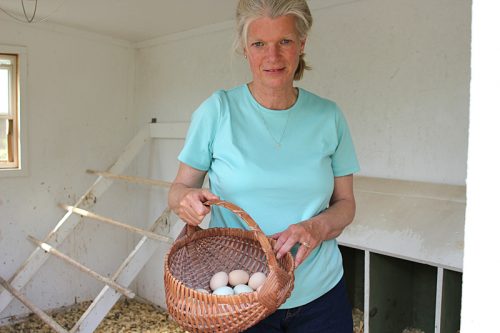
REBECCA’S FARM FRESH EGGS ARE EXACTLY where we’re headed next. It’s not that much of a livestock farm, there’s a couple of cows just for fun, Alan says, but they have a little flock of chickens which produce beautifully colored eggs. We depart as a group for the chicken coop, partly so I can take pictures of the whole group out here, but also because—that’s what you do on a farm, make your rounds through all the variety of nature it offers.
Most of the kids stay behind, to nap or play in the pool, but Lillie Shields tags along, or rather is carried by one or the other of her parents. I’ve enjoyed watching the kids on the periphery as I interviewed the adults; kids always seem their truest selves in nature, and I envy these city kids who get the freedom of this farm to run around in.
Which leads me to ask John Shields how often he comes down here. “Well, not enough, once a month I think right now, but I need to get down here more often,” he says. “Once I’m not making decisions about every little thing… hopefully the goal is a couple of times a week, once I’m in a position where I feel comfortable leaving and coming down here and working on the farm. I think that will help me with creativity and all that, and help me help Alan and Rebecca with saying, this is working, this isn’t working, tightening the relationship up like that.”
“We’re waiting for him to get down here because we’ve got a hoe and a bucket for the weeds and we want him to give us a hand,” Alan says.
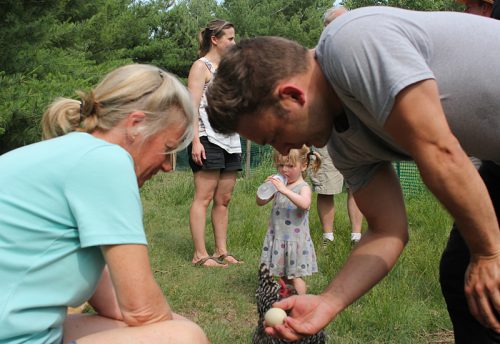
Sounds like a pleasant and even soul-nourishing way to work, for sure. But the thing I still wonder is—will this translate to the restaurant experience, on some level beyond the quality of the produce? What will the diner get from it?
The closest I come to an answer seems to be when he talks about wanting Smyth to feel like a home. I read that in earlier articles, and I didn’t really know what it meant—so it has curtains, or comfy chairs? But the way he answers me suggests more a philosophy that has baked in from his time here on the farm, and before it doing fine dining in a tiny town, far from the scene of a place like Chicago’s West Loop.
“I want it to be fun for everyone. I want it to be fun for [the Papineaus], they enjoy growing and I enjoy cooking. And really, I’m looking at these restaurants and kind of going back to when I was a cook and I was first getting into food, I enjoyed it. I loved it. And over time, you sort of rise the ranks and it becomes more of a job,” John says.
“So I’m trying to kind of hit the reset button with these projects. Having a good time with this. I think that will aid with the food and the atmosphere we’re trying to create at the restaurant, which is much more laid back than any other fine dining restaurants, or most of them that you see around the country, anyway. A few courses may push you to somewhere that you haven’t gone, but the feeling of the restaurant, and the people that work there, are excited to be there. I want them to be themselves. I don’t want any acts put on, any show. We’re real people. Why can’t we just be real?”

Michael Gebert plows the back forty of Fooditor.
Latest
Join the Discussion
After you comment, click Post. If you're not already logged in you will be asked to log in or register with Disqus.




















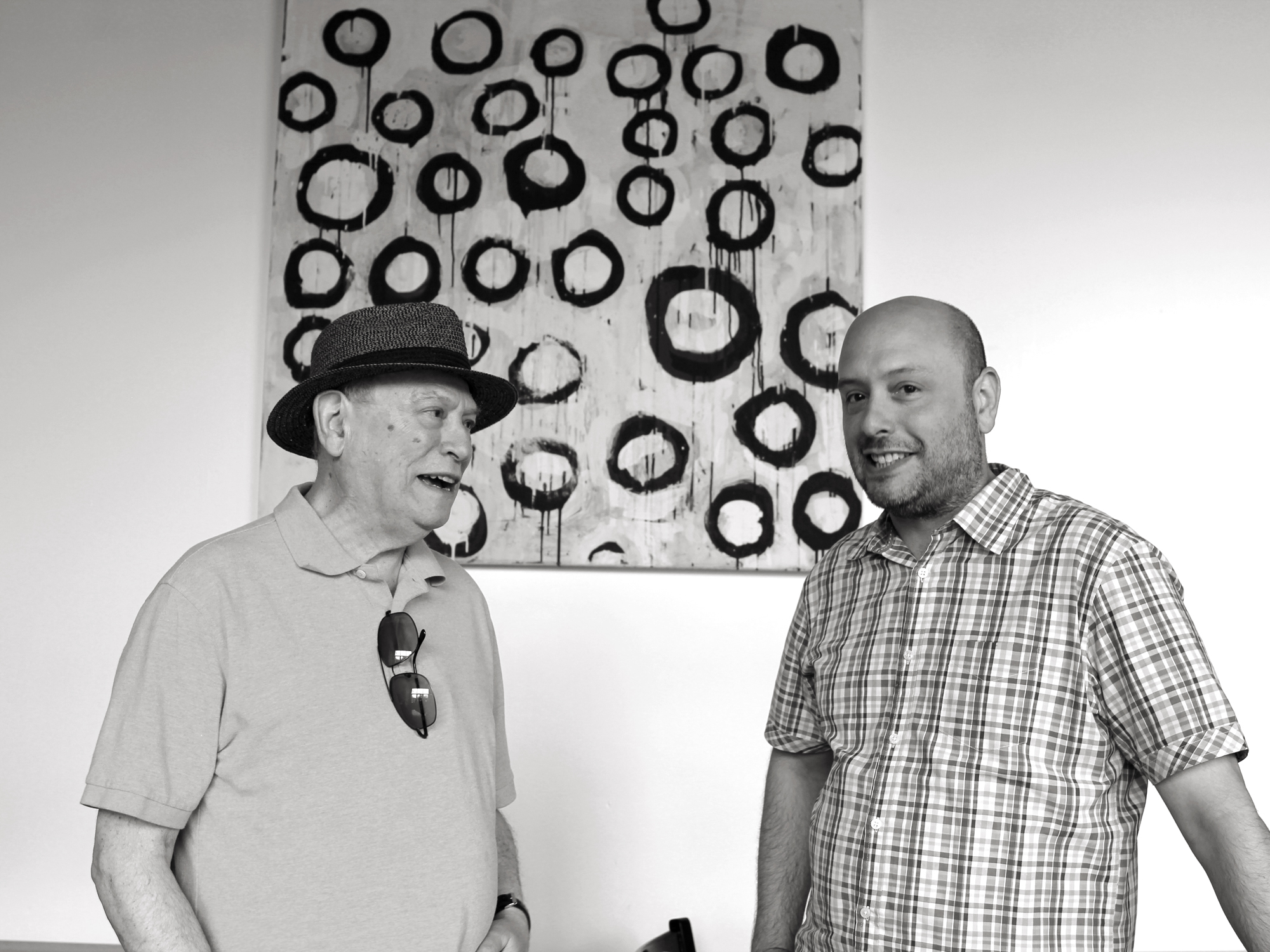


[…] Chicago Restaurant, Kankakee Farm, Fooditor […]
[…] the tea program, we are taking cues from the seasons as well. With our partnership with The Farm, we are fortunate to have accessibility to the freshest and most seasonal herbs and flowers, which […]